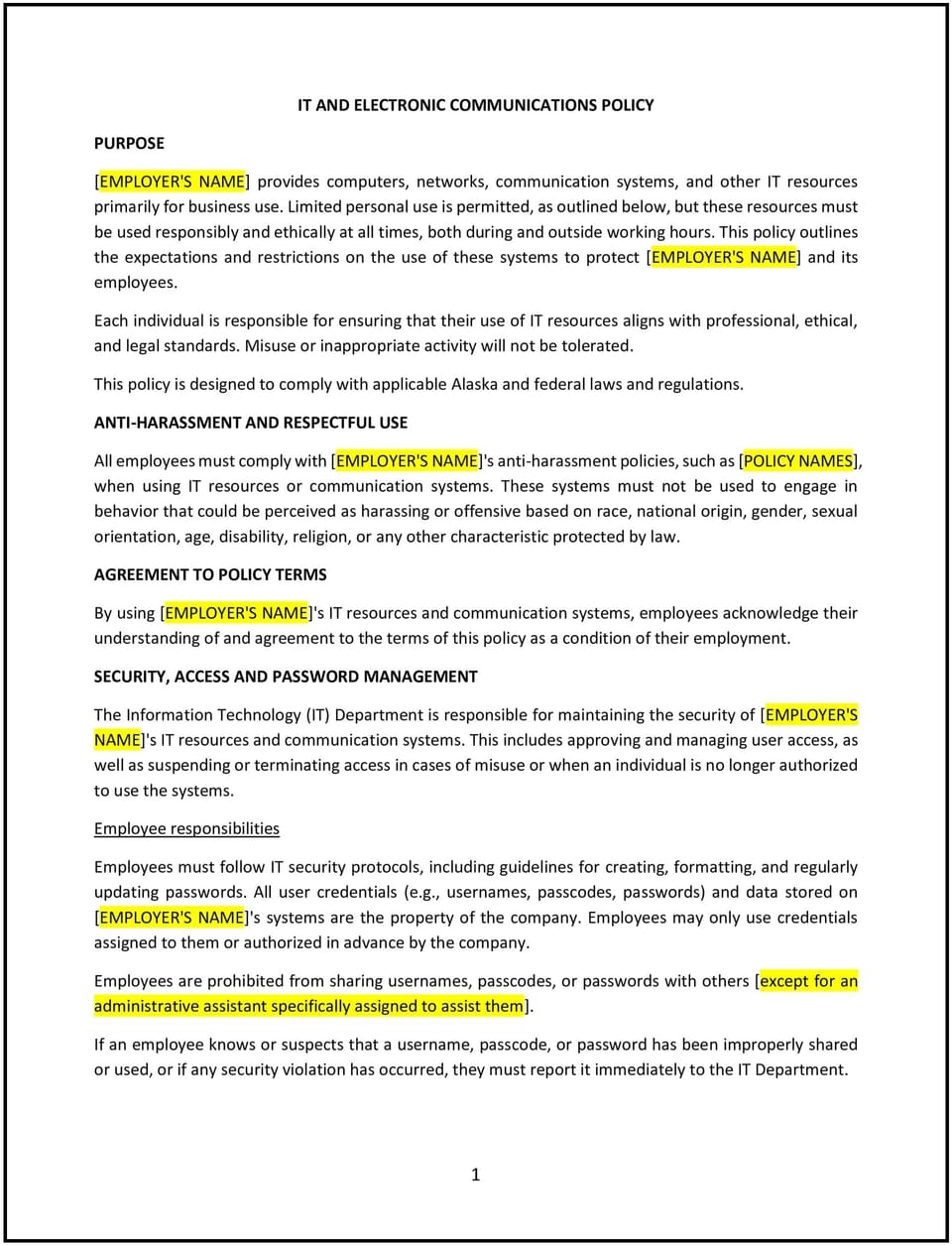IT and electronics communication policy (Alaska): Free template

IT and electronics communication policy (Alaska)
In Alaska, an IT and electronics communication policy establishes guidelines for the appropriate use of company-provided technology and communication systems. This policy ensures that employees use IT resources responsibly, safeguard sensitive information, and maintain compliance with legal and organizational standards. By implementing this policy, businesses can protect their digital assets, reduce cybersecurity risks, and promote efficient communication.
Given Alaska’s reliance on digital tools for remote work and geographically dispersed teams, businesses may need to address unique challenges such as internet connectivity, secure remote access, and data protection.
How to use this IT and electronics communication policy (Alaska)
- Define acceptable use: Clearly outline what constitutes appropriate use of company IT systems, such as email, internet, and software applications, for business purposes.
- Address cybersecurity protocols: Include guidelines for using strong passwords, multi-factor authentication, and secure file sharing to protect sensitive data.
- Restrict unauthorized activities: Prohibit activities such as personal use of IT resources, accessing inappropriate content, or installing unapproved software.
- Establish monitoring practices: Inform employees about the company’s right to monitor IT usage to ensure compliance and security.
- Provide training: Educate employees on the importance of cybersecurity, responsible use of IT resources, and compliance with the policy.
Benefits of using an IT and electronics communication policy (Alaska)
An IT and electronics communication policy provides several advantages for businesses in Alaska. Here’s how it helps:
- Enhances cybersecurity: Protects company systems and sensitive data from breaches or unauthorized access.
- Promotes productivity: Reduces distractions by limiting personal use of IT resources during work hours.
- Supports compliance: Helps businesses adhere to data protection laws and industry standards, reducing legal and reputational risks.
- Clarifies expectations: Ensures employees understand their responsibilities when using company-provided IT resources.
- Improves resource management: Encourages efficient use of IT systems, reducing costs associated with misuse or unauthorized activities.
Tips for using an IT and electronics communication policy (Alaska)
- Tailor for remote work: Include provisions for securing devices and accessing company systems from remote locations, which are common in Alaska.
- Use secure tools: Require employees to use company-approved software and tools to ensure consistent security standards.
- Monitor IT usage responsibly: Establish clear boundaries for monitoring employee activity to maintain trust while ensuring compliance with the policy.
- Regularly update systems: Keep IT systems and software updated to mitigate vulnerabilities and improve functionality.
- Review policy effectiveness: Collect employee feedback and analyze incidents to refine the policy and address emerging challenges.
Q: How can I ensure employees use IT resources responsibly?
A: Clearly communicate acceptable use guidelines and provide regular training on cybersecurity and the responsible use of company systems.
Q: What measures can I take to safeguard sensitive company data?
A: Implement strong security protocols, such as multi-factor authentication, data encryption, and secure file-sharing tools. Monitor systems regularly for potential vulnerabilities.
Q: How do I manage IT resources for remote employees?
A: Provide company-approved tools for remote access, enforce security measures like VPNs, and establish clear policies for securing devices in remote locations.
Q: What should I include in the policy to prevent misuse?
A: Define prohibited activities, outline monitoring practices, and set clear consequences for violations to ensure compliance and maintain productivity.
Q: How often should I review this policy?
A: Review the policy annually or whenever significant changes occur in technology, cybersecurity threats, or business operations.
This article contains general legal information and does not contain legal advice. Cobrief is not a law firm or a substitute for an attorney or law firm. The law is complex and changes often. For legal advice, please ask a lawyer.


